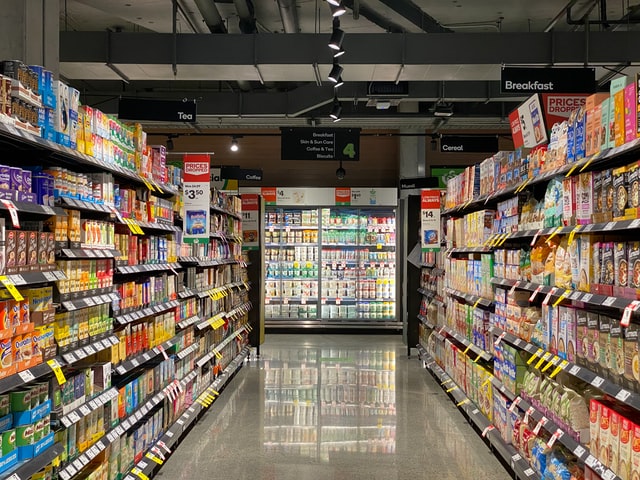Most consumers now have adapted to the life of online shopping. All you require is the internet on any digital device and fill your online shopping basket with whatever your heart desires and wait for it to appear on your doorstep.
E-commerce offers an array of advantages and sourcing the ideal product from the comfort of your sofa is only one of them. From checking customer reviews to applying discounting coupons and speeding through the check-out process, the are many appealing reasons for purchasing products online. What’s more, it allows buyers to find details and information on the items they are looking for. In fact, 96% of consumers tend to do their own online research before committing to a big purchase.
If e-commerce was already growing before the events of 2020, the pandemic has truly boomed its popularity. Among the several different sectors, grocery shopping has also become a more habitual virtual experience. But, as we finally shift back to some normality, what are the predictions for the future of food purchasing? Will physical shops effectively exercise their charm, or will the web keep enticing buyers? Electrix, expert manufacturers of electrical junction boxes, explore whether Americans will convert to online grocery shopping or stick to in-person store visits.
The growth of virtual grocery shopping
Prior to the pandemic, grocery shopping used to be carried out through the aisles of brick-and-mortar grocery stores. However, with the outbreak of a national and global health crisis, shoppers had to find alternative ways to safely get hold of their food and drinks.
As people were asked to stay indoors, online grocery shopping came as a welcomed solution. Up to that point, it is fair to say that food purchasing had resisted the world of e-commerce. But, in April 2020, over one-third of the American population resorted to ordering groceries online for the very first time. While perhaps a temporary answer to customers’ needs in what was a period of uncertainty, there is no denying that this virtual experience has certainly not faded out.
As of August 2021, 64% of US consumers had made food and drink purchases on the web. More specifically, 29% of American shoppers continue to place their grocery orders online on a weekly basis. There are a number of reasons for this ongoing trend.
Firstly, filling a virtual trolley with food and drinks is a comfortable, stress-free process for buyers. A study by Spryker Systems, an enterprise digital commerce platform, found that convenience is the key driver behind people’s decision to food-shop online. 35% of respondents, instead, identified health and safety as one of the main motives for favoring virtual supermarkets. Furthermore, one in five US consumers believe that they will mostly – if not exclusively – shop for groceries online within a couple of years.
It is clear to see that navigating the internet to fill one’s fridge was not an extemporary practice. To a wide extent, it is here to stay.
The appeal of physical stores
As mentioned, online grocery shopping is becoming a handy, weekly routine for many Americans. In this respect, Walmart seems to be consumers’ virtual retailer of choice, as it is the preferred online store for over one-third of US shoppers.
That said though, brick-and-mortar supermarkets have kept their special appeal. In fact, 54.5% of Americans – if given the option – would rather visit physical shops to collect their food and drinks than tick off their shopping list online. Why?
One of the main advantages of in-store shopping is that customers have the chance to ‘engage’ with products. By seeing and, in some instances, smelling the scent of specific foods, shoppers can possibly enjoy a more meaningful experience that cannot be achieved through a screen. Also, checking things personally, from the color to the size of the item, can actively persuade a person to buy the product.
Moreover, visiting a physical supermarket means that the customer can save on delivery costs. Not only that, but by checking food aisles in person, shoppers can fill their trolley with drinks and ingredients and start cooking as soon as they get home.
Finally, an excellent way to make stores more attractive is to implement what works in the online world. Pay-as-you-scan devices, for instance, can act as quick, smooth checkout systems to reduce waiting time and stress. What’s more, digital assistants on shop shelves can be a great touch to improve customers’ experience too. In the style of ‘Amazon Go’ physical stores, having devices scattered around the shop that offer descriptions of in-store products will unite both the physical and virtual worlds. Ultimately, it is the ideal blend between browsing through the aisles and benefitting from the advantage of online information.
There is no hiding that online grocery shopping is becoming an experience that more and more US consumers are happy to embrace. However, it is also safe to say that physical stores certainly do not belong to the history books. As things stand, it is difficult to predict what shopping routine Americans will favor in the long term. However, it will be exciting to witness how both e-commerce and physical grocery supermarkets will evolve in the near future.
Sources
https://www.emarketer.com/content/us-generation-z-shopping-behaviors
https://www.dontpayfull.com/explore/online-shopping-vs-in-store-shopping


